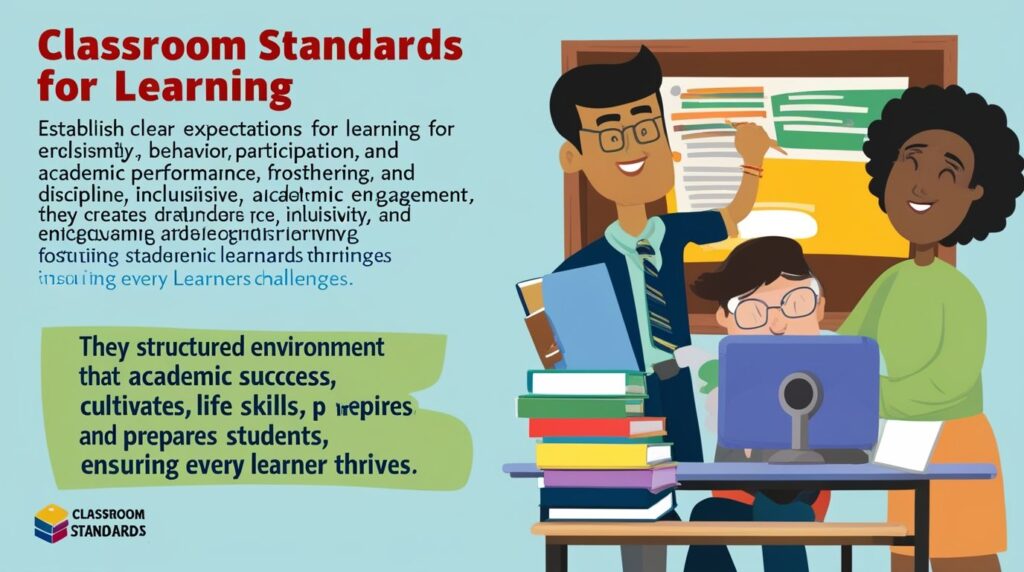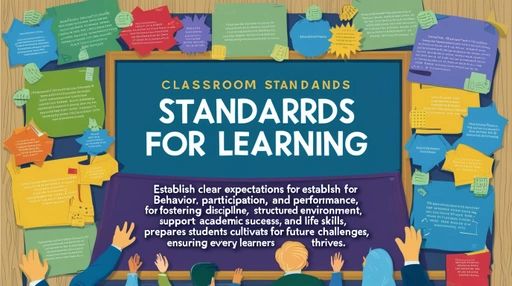Introduction
Classroom Standards for Learning, Classroom standards for learning are essential benchmarks that guide teaching practices and ensure students achieve academic and personal growth. These standards establish clear expectations for both educators and learners, fostering a structured and effective learning environment. By setting guidelines on behavior, academic performance, and collaborative engagement, classroom standards play a pivotal role in enhancing the quality of education and preparing students for future success.
Defining Classroom Standards
Classroom standards encompass the rules, expectations, and objectives designed to create a productive learning environment. They address areas such as discipline, academic integrity, participation, and interpersonal relationships. By adhering to these standards, students develop critical skills, including responsibility, respect for others, and effective communication, which are integral to both academic success and personal development.
The Role of Classroom Standards in Learning
- Promoting Discipline and Order
Classroom standards provide a framework for maintaining discipline and order. Clear rules about punctuality, attendance, and behavior help minimize disruptions and maximize learning time. For instance, requiring students to arrive on time and stay attentive during lessons fosters an environment where learning takes precedence. - Enhancing Academic Performance
Standards set clear academic expectations, encouraging students to strive for excellence. Rubrics for assignments, standardized grading criteria, and benchmarks for progress ensure that students understand the level of effort and quality required. This clarity motivates learners to meet or exceed expectations, resulting in improved academic outcomes. - Encouraging Active Participation
Effective classroom standards emphasize active participation and collaboration. Guidelines on group work, class discussions, and peer reviews create opportunities for students to engage with the material and their peers. Active participation not only deepens understanding but also develops critical thinking and communication skills. - Fostering Respect and Inclusivity
Standards that prioritize respect and inclusivity cultivate a positive classroom culture. Expectations for treating others with kindness, listening actively, and embracing diverse perspectives ensure that every student feels valued and safe. This inclusive environment is essential for nurturing creativity and innovation.
Key Components of Effective Classroom Standards
- Clarity and Consistency
Standards must be clearly communicated and consistently enforced to be effective. Teachers should articulate rules and expectations at the beginning of the term and reinforce them regularly. Consistency ensures fairness and helps students internalize these standards as part of their learning routine. - Alignment with Educational Goals
Classroom standards should align with broader educational objectives, including critical thinking, collaboration, and ethical behavior. For example, incorporating standards that encourage questioning and problem-solving supports the development of analytical skills. - Flexibility and Adaptability
While consistency is important, classroom standards should also be flexible enough to accommodate diverse learning needs and circumstances. Adaptable standards ensure that all students, regardless of their background or abilities, can thrive in the classroom. - Student Involvement
Involving students in setting classroom standards increases their ownership and accountability. Collaborative discussions about rules and expectations encourage students to respect and adhere to them, as they feel a sense of agency in shaping their learning environment.

Implementing Classroom Standards
- Setting Clear Expectations
At the start of the academic year, teachers should outline classroom standards through discussions, visual aids, and written guidelines. This initial step ensures that students understand what is expected of them. - Modeling Positive Behavior
Teachers play a crucial role in exemplifying the standards they wish to see in their students. By demonstrating punctuality, respect, and enthusiasm for learning, educators set a powerful example for students to follow. - Reinforcing Standards Regularly
Periodic reinforcement of classroom standards helps maintain their relevance. This can be achieved through reminders, feedback, and constructive discussions about their importance in achieving learning goals. - Providing Constructive Feedback
Feedback is essential for helping students understand how well they are meeting classroom standards. Constructive criticism, combined with praise for positive behaviors, encourages continuous improvement.
Benefits of Classroom Standards
- Improved Learning Outcomes
Structured classrooms with clear standards create an optimal environment for academic achievement. Students are more likely to stay focused, motivated, and engaged in their studies. - Development of Life Skills
Adhering to classroom standards fosters essential life skills such as time management, responsibility, and teamwork. These skills are invaluable for personal and professional success beyond the classroom. - Enhanced Teacher-Student Relationships
When standards are clear and fair, students are more likely to trust and respect their teachers. This positive relationship enhances the overall learning experience and encourages open communication. - Preparation for Future Challenges
Classroom standards prepare students for future academic and professional settings by teaching them the importance of discipline, collaboration, and ethical behavior.
Conclusion
Classroom standards for learning are the cornerstone of an effective educational experience. By establishing clear expectations and fostering a respectful and inclusive environment, these standards ensure that students develop academically, socially, and emotionally. Teachers, students, and parents must work collaboratively to uphold these benchmarks, ensuring that the classroom remains a place where every learner can thrive. With well-implemented standards, the journey of learning becomes not only structured but also inspiring and transformative.

8 thoughts on “Classroom Standards for Learning”
Comments are closed.